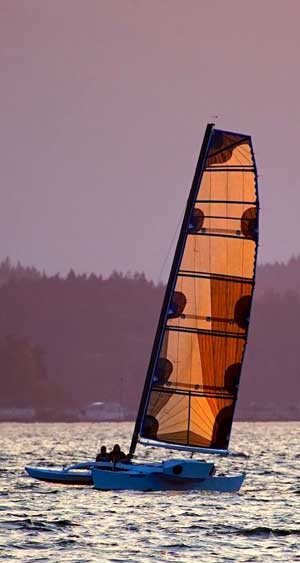Kurt Hoehne looks at the Race to Alaska and the Team Pure and Wild proa entry.

Team Pure and Wild seatrials their new Brown Bieker proa off Shilshole. Photo by Peter Howland photography.
By Kurt Hoehne
In today’s world, there are few adventures with Big Questions. It seems every adventure has been done at least once before. Somebody’s going to find a new route to the summit, win the game on a superlative performance or lucky bounce, or find that extra bit of speed around the race. Those are relatively Little Questions.
Maybe that’s the appeal of the inaugural Race to Alaska (R2AK). It asks Big Questions. There aren’t a whole lot of rules other than make your way to Ketchikan via boat. The boat can’t have an engine and has to pass through only three checkpoints along the way. Use whatever boat you want and go the route you want.
There’s no big safety equipment checklist (there is a little one, however). There are no scantlings to adhere to, no nanny boats to accompany the fleet. The race organizers are leaving it to the competitors to manage the dangers themselves.
“It’s like the Iditarod. With a chance of drowning, being run down by a freighter or eaten by a grizzly bear.”
– from the Northwest Maritime Center R2AK web site and promotional material.
To understand the race, you have to know a little bit about the race founder, Jake Beattie. He’s a Northwesterner through and through. He spent 3 years on tall ships, three years with Outward Bound, worked in commercial shipping sector and at the Center for Wooden Boats. He is now the Executive Director at the Northwest Maritime Center in Port Townsend. To say he’s passionate about getting people on the water is a profound understatement.
It doesn’t take much to get him to say what he really feels about boating. “Boating is in trouble,” he says. “Every year a new gadget comes out and every year it gets more expensive. At the same time disposable income and the middle class are decreasing.”
Praise Neptune! We’re with you Jake, go on!
story continues here Wave Writer – The Iditarod with a Chance of Drowning on Northwest Yachting